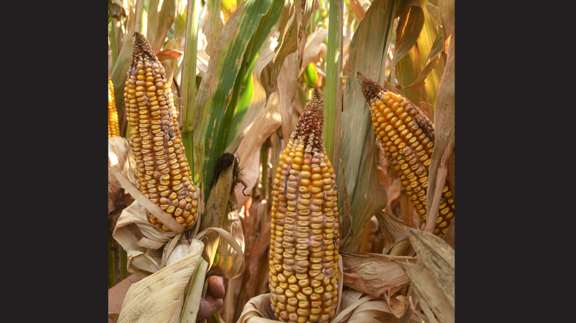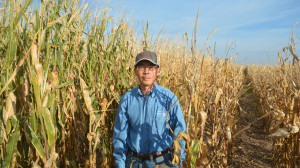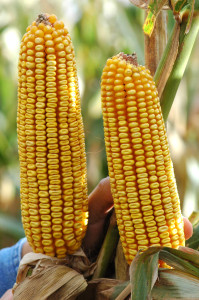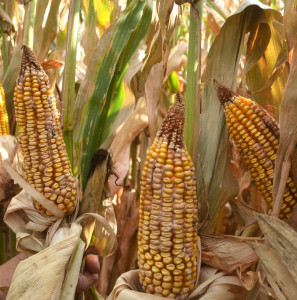Farm & Ranch
AgriLife research scientist: Delay corn planting in stressful years

By: Kay Ledbetter
Writer: Kay Ledbetter, 806-677-5608, [email protected]
Contact: Dr. Qingwu Xue, 806-354-5803, [email protected]
AMARILLO – A wet spring filled with hail storms brought challenges to this year’s corn crop, some that a Texas A&M AgriLife Research scientist said could have been avoided if planting was delayed by a couple weeks or more.
Dr. Qingwu Xue, AgriLife Research plant physiologist in Amarillo, said he did not intentionally start out emphasizing planting dates on his corn studies. But what he saw on his hybrid trials near Bushland showed what a tremendous difference the planting date can make in a stressful year.
Xue said he generally plants anywhere from three to five different corn trials on the AgriLife Research farms around Bushland, including some comparing hybrid production under different irrigation rates and others for chemical efficacy.
“It seems every year the Texas High Plains presents its own unique challenges,” Xue said. “Some years it is drought, but this year was a historically wet year that included hail storms and insect and disease problems.”
He planted corn on four dates this year. The first two planting dates were May 18 and June 3. A hailstorm with severe wind struck on June 14 and caused losses of up to 60 percent of the stand on the May 18 planting.
“But because the growing point of the June 3 planting was still below ground, corn plants simply resprouted and we lost very few plants,” Xue said.
The third and fourth planting dates were June 17 and June 19. The June 19 planting was a replant of some of the May 18 trials that were severely hail damaged, he said.
“Two hail storms in early July caused some damage to the corn planted on June 3, however there was little to no stand loss for corn planted on June 17 and June 19,” Xue said, adding the last two plantings produced the best corn they saw this year in their trials.
“So planting dates really did make a difference,” he said. “If you get the hail damage in the early vegetative stage, you don’t get as much damage to yields, but if the plant is already big, you get greater stand damage.”
Additionally, the side-by-side plots of corn suffered various insect attacks, primarily grasshoppers, as well as earworms and fungal diseases, Xue said.
He said among his trials was a comparison of the different hybrids for their protection against ear damage from disease and insects.
“Producers need to make sure the hybrid they are buying has a good ear protection trait included in it, because we saw a clear difference between hybrids this year with all of the heavy insect and disease pressure,” he said.
“What we learned this year is just don’t rush to plant your corn too early,” he said. “The traditional planting dates in this area are late April or early May. However, corn we planted on June 19 is still the best corn we got this year.
“I would say if you would delay your planting date, you can avoid some of the heavy hail damage that can accompany spring storms.”
Xue said, however, that producers who decide to delay their planting date should be mindful of the hybrid they plant.
“You don’t want to use the long-season hybrids; 120-day corn is probably too risky with delayed planting,” he said. “If your corn is under full irrigation or well-watered, the longer-season hybrids have the greatest yield potential.
“But in years when the weather is drier and you only can use limited irrigation or you are delaying planting, you should use a mid-season or short-season hybrid and it will give you more flexibility in your operation.”
-30-
Find more stories, photos, videos and audio at http://today.agrilife.org
Farm & Ranch
Hazards of Backyard Poultry

By Barry Whitworth, DVM
Having backyard poultry is a popular agriculture enterprise. According to the United States Department of Agriculture, 0.8 percent of all households in the United States have chickens. People keep chickens for a variety of reasons with table eggs being one of the more common reasons.
Unfortunately, some of these poultry producers are not aware of the hazards that come with keeping poultry because many times they carry pathogens but appear healthy.
Chickens are carriers of several zoonotic diseases. These are diseases that can be passed from animals to humans. According to a recent survey in Pennsylvania, a majority of backyard poultry producers were aware of the dangers of avian influenza. However, this study also revealed that far fewer producers were aware of the risk of possible exposure to Salmonella and Campylobacter.
The lack of knowledge about the hazards of raising poultry likely contributes to the continued issues of Salmonella outbreaks associated with backyard poultry. In 2023, the Centers for Disease Control and Prevention reported 1,072 illnesses of Salmonella linked to backyard poultry, and 272 of those patients required hospitalization. Oklahoma reported 43 individuals with the disease.
To read more, pick up a copy of the April issue of NTFR magazine. To subscribe by mail, call 940-872-5922.
Farm & Ranch
Ag Elsewhere: Wyoming

By Tressa Lawrence
Babies are tucked away in every nook and cranny. Many ranchers across Wyoming have baby animals popping up all over this time of year.
Farm & Ranch
Ag Elsewhere: Montana

By Lindsey Monk
Another load of grain in to keep feeding the calves until the green grass can really start popping.
-

 Country Lifestyles1 year ago
Country Lifestyles1 year agoScott & Stacey Schumacher: A Growth Mindset
-

 Equine7 months ago
Equine7 months agoThe Will to Win
-

 Country Lifestyles7 years ago
Country Lifestyles7 years agoStyle Your Profile – What your style cowboy hat says about you and new trends in 2017
-

 Country Lifestyles4 years ago
Country Lifestyles4 years agoAmber Crawford, Breakaway Roper
-

 HOME7 years ago
HOME7 years agoGrazing North Texas – Wilman Lovegrass
-

 Country Lifestyles7 years ago
Country Lifestyles7 years agoDecember 2016 Profile, Rusty Riddle – The Riddle Way
-

 Country Lifestyles8 years ago
Country Lifestyles8 years agoJune 2016 Profile – The man behind the mic: Bob Tallman
-

 Outdoor9 years ago
Outdoor9 years agoButtercup or Primrose?









